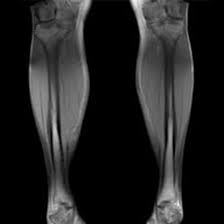Fill out form to enquire now
MRI Screening Of Bilateral Legs
Medintu has collaborated with the best pathology laboratories that are NABL and NABH certified and follow ISO safety guidelines to provide the best MRI Screening Of Bilateral Legs at an affordable price for needy individuals. Legs are involved in all activities of daily living and therefore, anatomy and function of legs which are altered as a result of injury, disease or degeneration has a profound effect on an individuals’ mobility and well-being. Bilateral legs, including muscles, tendons, and ligaments, bones, and nerves are prone to injuries, which can be acute, such as fractures and sprains, and chronic, including arthritis or nerve impingement.
MRI screening of the bilateral legs is also a non-invasive detailed way to look at these structures. MRI employs both magnetic fields and radio waves to generate highly detailed images of soft tissues, bones and blood vessels providing a detailed structural map of segments of the legs. It is also especially useful in orthopedic and traumatic problems, vascular disorders, arthritic or other joint pathological situations, and neural conditions. It proves to be a crucial diagnostic tool for patients that continue to experience leg pain, weakness or any other symptom in any part of the lower limbs because using other less detailed imaging techniques, doctors would not identify the main cause of the problem. To schedule an appointment for MRI Screening Of Bilateral Legs, simply contact Medintu or call our customer care at +919100907036 or +919100907622 for more details and queries.
Indications for MRI Screening of Bilateral Legs
This kind of scan is usually ordered for a patient who insists on complaining of continued or unexplained symptoms occurring in the two legs. The following are amongst the most common reasons patients go for this kind of scanning:
- Continuous or One-Sided Leg Pain
Chronic Pain: If the pain in both the legs is chronic and does not appear to have a clear cause, then it is possible that an MRI can reveal torn muscles, joint problems, or nerve impingement.
Radiating Pain: Pain that originates in the lower back, hips, or knees and radiates down into both legs is more likely to be a spinal pathology such as a herniated disc or sciatica. Therefore, MRI can be diagnostic.
- Trauma or Injury
Bilateral Injuries: Maybe an accident or sport can lead to bilateral injuries of the legs; diagnoses with the aid of MRI on soft tissue injuries, fractures, and even dislocations can be made.
Strains/Tears in Muscles or Tendons: They are usually linked with athletes; however, sprains or strains are readily visualized by the MRI even in muscles or tendons forming the quadriceps, hamstrings, or calf muscles.
- Neurological Signs
Legs numbness, tingling, or pins and needles could be conditions related to nerve compression, an injury like sciatica or peripheral neuropathy, and even stenosis.
Weakness or Paralysis: Weakness or paralysis of both legs are more likely to be because of pathology at the nerve roots or in the spinal cord, which should be seen with MRI, among other neurological diseases.
- Vascular Conditions
PAD: Either or both legs can experience pain of cramp or weakness caused by poor circulation; thus, an MRI will display either obstruction or narrowing of the vascular anomaly in any leg artery
DVT: Deep vein thrombosis might be suspected through swelling and pain in the limbs; thus, an MRI will display the existence of clots in the vein.
- Musculoskeletal Disorders
Arthritis and Joint Degeneration: MRI is crucial in diagnosing osteoarthritis, rheumatoid arthritis, and other inflammatory joint diseases of knees, hips, or ankles.
Fluid in the joint spaces of the lower limbs may sometimes be visualized on an MRI in association with arthritis or trauma.
Soft Tissue Masses: Tumours, cysts, or lipomas in soft tissue within the legs may be considered as an explanation for pain and impairment by an MRI.
Benefits of MRI for Bilateral Legs Screening
MRI is a very powerful, non-invasive diagnostic tool that has many advantages when used for bilateral leg screening. The advantages of using MRI for bilateral leg screening are as follows:
- Non-Invasive and Safe Imaging Technique
No Ionizing Radiation: Unlike X-rays or CT scans, MRI does not use ionizing radiation, making it a safer option, especially for those individuals who require multiple imaging studies.
Non-Invasive: MRI is non-invasive and does not require surgery and penetration of the skin; hence, it is advantageous for diagnosing conditions not requiring potentially harmful procedures.
- High-Resolution Images
Detailed Soft Tissue Imaging: MRI provides exceptional clarity of soft tissues including muscles, tendons, ligaments, nerves, and blood vessels. It is extremely useful to diagnose musculoskeletal injuries or soft tissue masses and also nerve compression.
Bone and Joint Imaging: MRI also has the advantage of providing exquisite details for bone and joint pathology that might help detect fracture, joint degeneration, arthritis, and other diseases involving bones.
- Both Legs will be fully examined
Simultaneous assessment: MRI allows the assessment of both legs at the same time. It is an extremely useful tool in making a diagnosis of bilateral conditions or to compare the left and right legs to ascertain asymmetry or imbalance. It is specifically very helpful for conditions that present bilaterally, such as peripheral vascular disease or bilateral arthritis.
Holistic Diagnosis: The MRI scan enables doctors to visualize muscles, tendons, ligaments, joints, bones, and blood vessels of both legs together.
- Early Pathology Detection
MRI can identify slight conditions not observable in X-rays, including minor fractures, tears in soft tissues, the beginning of arthritis, or even herniated discs. This would guarantee that the patient gets more appropriate treatment and results.
Tracking Chronic Diseases: Patients with such chronic diseases as arthritis and tendonitis undergo regular magnetic resonance imaging to track the developments of the diseases or effective treatments.
- Detailed Muscle and Neurological Disease Evaluation
Muscle and Tendon Trauma: There is no other imaging technique than MRI that surpasses it for diagnosing muscle strain, tears, and tendinopathies in several muscles of the lower limbs of quadriceps, hamstrings, and calves.
Ligament and Joint Conditions: Ligament trauma, such as a tear of an ACL, and joint disease such as osteoarthritis or inflammatory arthritis of knees, hips, or ankles are significantly evaluated using MRI.
Conditions Detected by MRI Screening of Bilateral Legs
MRI scanning of bilateral legs is a very diagnostic method which helps identify many conditions that affect bones, joints, muscles, tendons, ligaments, nerves, and the blood vessels. The major conditions diagnosed through MRI imaging include the following:
- Musculoskeletal Conditions
Muscle Strains and Tears: MRI can detect strains or tears in the muscles of both legs, such as the quadriceps, hamstrings, calf muscles, and hip flexors. It is more useful in detecting tears that would not be visible in an X-ray.
Tendon Injuries: Conditions such as tendinitis, tendonitis (inflammation of tendons), and tendon tears, such as Achilles tendon rupture, can be detected using MRI, which shows a detailed image of the tendons.
Ligament Injuries: MRI is excellent for identifying ligament tears or sprains, especially the knee (e.g., ACL tears) and ankle (e.g., lateral ankle sprain). It does provide very fine images of the ligaments and helps evaluate the integrity of the ligaments.
- Bone Pathologies
Fractures and Stress Fractures: MRI is highly sensitive in the detection of fractures, small or stress fractures in bones of the legs, that may not be visible in the X-rays, such as in the tibia, fibula, femur, or foot bones.
Bone Infections (Osteomyelitis): MRI is the best modality to diagnose osteomyelitis, which is a bacterial infection of the bone. It allows one to see infections within bones and soft tissues. The information obtained is needed to understand the extent of disease as well as guide appropriate management.
- Vascular Conditions
Peripheral Arterial Disease: Use of MRI to determine flow through arteries that may feed the legs and is referred to as PAD. Areas in which there are either blockages or narrowing will appear and can cause areas of pain, cramping, and fatigue.
Deep Vein Thrombosis (DVT): The MRI may reveal clots of blood in the veins of the lower limbs, most especially in the deep veins. It is very helpful if the diagnosis is indeterminate on other imaging studies, including ultrasound.
- Neurological Disorders
Nerve Compression: MRI may indicate the presence of nerve compression in the lumbar region by a herniated disc or spinal stenosis that causes symptoms such as pains, numbness, weakness, or tingling in both legs.
Sciatica: This confirms the diagnosis of sciatica. The latter is the irritation or compression of the sciatic nerve. The imaging study further shows the amount of nerve compression or bulging in the lower lumbar portion that may affect the legs bilaterally.
- Soft Tissue Masses
Cysts: Fluid-filled cysts in soft tissues of legs, such as ganglion cysts, which are commonly found near the joints and tendons, can be detected by MRI. Such cysts may cause swelling or pain.
Lipomas: Lipomas are benign tumors made of fatty tissue, which may occur in the soft tissues of legs. The features of their soft tissues make them easily detectable through MRI.
- Test Type: MRI Screening Of Bilateral Legs
- Preparation:
- Wear a loose-fitting cloth
- Fasting not required
- Carry Your ID Proof
- Prescription is mandatory for patients with a doctor’s sign, stamp, with DMC/HMC number; as per PC-PNDT Act
- Reports Time: With in 4-6 hours
- Test Price: Rs.7000
How to book an appointment for a MRI Screening Of Bilateral Legs?
To schedule an appointment for MRI Screening Of Bilateral Legs, simply contact Medintu or call our customer care at +919100907036 or +919100907622 for more details and queries.
What is an MRI and what does it do for screening of the legs?
It is a form of MRI, or Magnetic Resonance Imaging, that is a nonsurgical medical imaging technique that includes powerful magnets and radio waves. For leg screening, it provides high-quality images of muscles, tendons, ligaments, bones, blood vessels, and nerves that help in diagnosing various conditions affecting the legs.
Is MRI of the bilateral legs safe for screening?
Yes, MRI is a safe procedure. Unlike X-rays and CT scans, MRI does not employ ionizing radiation. However, it may not be appropriate for patients with certain metallic implants (such as pacemakers or some types of prosthetics) because of the strong magnetic field used in the procedure. Always inform your doctor of any implants or devices before undergoing an MRI.
Why would I need an MRI on both of my legs?
You may require an MRI if you are experiencing any symptoms such as unexplained pain, weakness, numbness, swelling, or injury in both legs. It is also used to evaluate the conditions affecting both legs like peripheral vascular disease, arthritis, or nerve compression, and also diagnose musculoskeletal injuries or other disorders that may affect both sides.
How long does it take to have an MRI of both legs?
The length of the MRI scan varies depending on the complexity of the case, but usually takes about 30 to 60 minutes. It is not painful, but you have to lie still for a pretty long time to ensure good imaging.
Is the MRI screening of the bilateral legs painful?
No, MRI itself is not painful. Though it may be uncomfortable to remain stationary for a long period of time if a person has any kind of pain or injury in the legs. The machine also might be noisy, but ear protection usually is provided so as not to cause too much noise disturbance.
What conditions can be diagnosed with an MRI of the bilateral legs?
It is possible for the bilateral legs’ MRI to diagnose several conditions, which include the following:
- Muscle injuries like sprain or tears
- Tendon and ligament injuries
- Fractures or stress fractures
- Arthritis and joint degeneration
- Vascular conditions that may be peripheral arterial disease or deep vein thrombosis
- Nerve compression, sciatica, or neuropathy
- Soft tissue masses, which can be cysts or tumors
- Infections or inflammation in the legs
Do I need to prepare for an MRI of my legs?
The preparation for the test is minimal. They will take off from you any metal adornments like jewelry, watches, belts, etc., because metallic items interfere with the scan. If it is essential to use a contrast agent that could provide clear imaging, you’ll be informed way before hand. And generally, loose-fitting clothing and no metallic hooks or zip fasteners helps.
MRI can diagnose cases of both soft tissue conditions and those of bone disorders in your legs?
Yes, MRI images the soft tissues (muscles, tendons, and ligaments) as well as the bones with great efficiency. Therefore, it ought to be considered a first-class diagnostic tool in respect to diseases involving several parts of the legs simultaneously.
Why Choose Medintu for MRI Screening Of Bilateral Legs?
Medintu is an online medical consultant, which offers home services not only in your city but also in all major cities of India, such as Hyderabad, Chennai, Mumbai, Kolkata and others. This makes it easy for us to work with diagnostic centers that boast of having the most accurate equipment. The customer service for booking the appointment of the services is available 24/7 and Medintu also comes with instructions. Medintu has not only the best diagnostic centres, but it offers them at very cheaper prices. If you have been tested, you can promptly schedule an appointment with a health care service through our list of skilled physicians. For appointment for MRI Screening Of Bilateral Legs, you can chat with us through Medintu or call our customer care at 919100907036 or 919100907622 for more information or inquiries.





